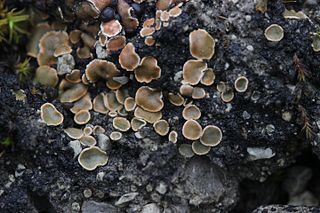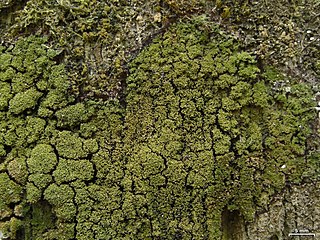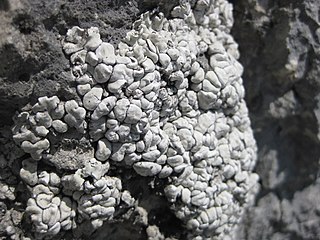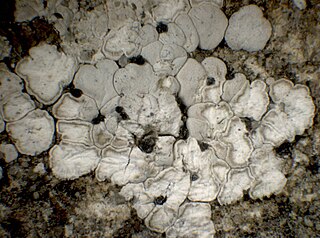
Psora is a genus of lichen-forming fungi in the family Psoraceae. Members of the genus are commonly called fishscale lichens. Lichens in the genus Psora generally have a squamulose thallus and anthraquinones in the hymenium. Photobiont partners of Psora lichens include members of the green algal genera Asterochloris, Chloroidium, Myrmecia, and Trebouxia.
Scutula is a genus of lichenicolous fungi in the family Ramalinaceae.

The Ramalinaceae are a family of lichen-forming fungi in the order Lecanorales. First proposed by Carl Adolph Agardh in 1821, the family now comprises 63 genera and about 750 species. Ramalinaceae lichens exhibit diverse growth forms, including crustose, fruticose, squamulose, leprose, and byssoid thalli, and form symbiotic relationships primarily with green algae of the genus Trebouxia. The family is characterised by pale-coloured thalli, apothecia that are typically pale but may darken with age, and ascospores that vary in shape and septation.

Ramalina is a genus of greenish fruticose lichens that grow in the form of flattened, strap-like branches. Members of the genus are commonly called strap lichens or cartilage lichens. Apothecia are lecanorine.
Crustospathula is a genus of five species of crustose lichens in the family Malmideaceae. They are characterized by their stalked and sometimes branched cartilaginous soredia and Bacidia-like apothecia.

Schadonia is a genus of lichen-forming fungi. Established by German lichenologist Gustav Wilhelm Körber in 1859, this genus of crustose lichens is characterised by its black, sessile apothecia, muriform ascospores, and growth on mosses, plant debris, and rocks in montane habitats. While traditionally placed in the family Ramalinaceae, recent studies have suggested its classification may be uncertain within the order Lecanorales, with some researchers proposing its placement in the Pilocarpaceae or the resurrection of the family Schadoniaceae. The genus currently comprises four recognised species.

Phyllopsora is a genus of lichen-forming fungi in the family Ramalinaceae.

Mazosia is a genus of lichen-forming fungi in the family Roccellaceae.

Megalaria is a genus of lichen-forming fungi in the family Ramalinaceae. It contains 44 species of crustose lichens, the majority of which grow on bark.

Malmideaceae is a family of crustose and corticolous lichens in the order Lecanorales. It contains eight genera and about 70 species.
Bibbya is a genus of fruticose lichens in the family Ramalinaceae.
Biatora oxneri is a species of corticolous (bark-dwelling) lichen in the family Ramalinaceae. It is found in the Russian Far East and in South Korea.
Phyllopsora amazonica is a species of corticolous (bark-dwelling), crustose lichen in the family Ramalinaceae. It is found in the Amazon rainforest of Brazil.
Phyllopsora concinna is a species of corticolous (bark-dwelling), squamulose (scaley) lichen in the family Ramalinaceae. Found in Central and South America, it was formally described as a new species in 2019 by lichenologists Sonja Kistenich and Einar Timdal. The lichen has a scaley, effuse (spread-out) thallus that is pale green with a well-developed, white prothallus. Apothecia occur rarely; they are brownish with a paler margin, measuring up to 1 mm in diameter. Ascospores are simple with a narrow ellipsoid to fusiform shape, and dimensions of 12.5–16·0 by 3.5–4.0 μm. Atranorin and parvifoliellin are major lichen products that occur in this species. The latter compound distinguishes it chemically from the morphologically similar species Phyllopsora cinchonarum, which instead contains lobaric acid. The botanical name concinna, refers to its "beautiful" appearance.

Thalloidima is a genus of lichen-forming fungi in the family Ramalinaceae. It has 13 species.

Porpidinia is a genus of lichen-forming fungi in the family Lecideaceae. It has two species of saxicolous (rock-dwelling) lichens. The type species of the genus, Porpidinia tumidula, thrives in a variety of settings from coastal to mountainous areas, primarily on lime-rich rocks, and is widely spread across southern to northern Europe, northern Africa, parts of Asia, and New Zealand. Meanwhile, Porpidinia brevispora is more regionally confined, found specifically in the Sikhote-Alin range in the Russian Far East, favouring carbonate rocks at lower altitudes.

Romjularia is a fungal genus in the family Lecideaceae, containing the single species Romjularia lurida, a saxicolous and terricolous squamulose lichen.
Meridianelia is a fungal genus in the family Elixiaceae. It consists of the single species Meridianelia maccarthyana, a corticolous (bark-dwelling), crustose lichen. This lichen forms greyish-white, crust-like growths on tree bark in subalpine woodlands of Tasmania, Australia. Discovered in 2003 and scientifically described in 2009, Meridianelia is classified in the small fungal family Elixiaceae based on its genetic and structural characteristics. The genus is notable for its unique reproductive structures and its apparent rarity, having been found in only a few locations despite growing in a relatively common type of forest.

Kiliasia is a genus of lichen-forming fungi in the family Ramalinaceae. It comprises seven species.

Bellicidia is a fungal genus in the family Ramalinaceae. It comprises the single species Bellicidia incompta, a widely distributed corticolous (bark-dwelling) crustose lichen.












